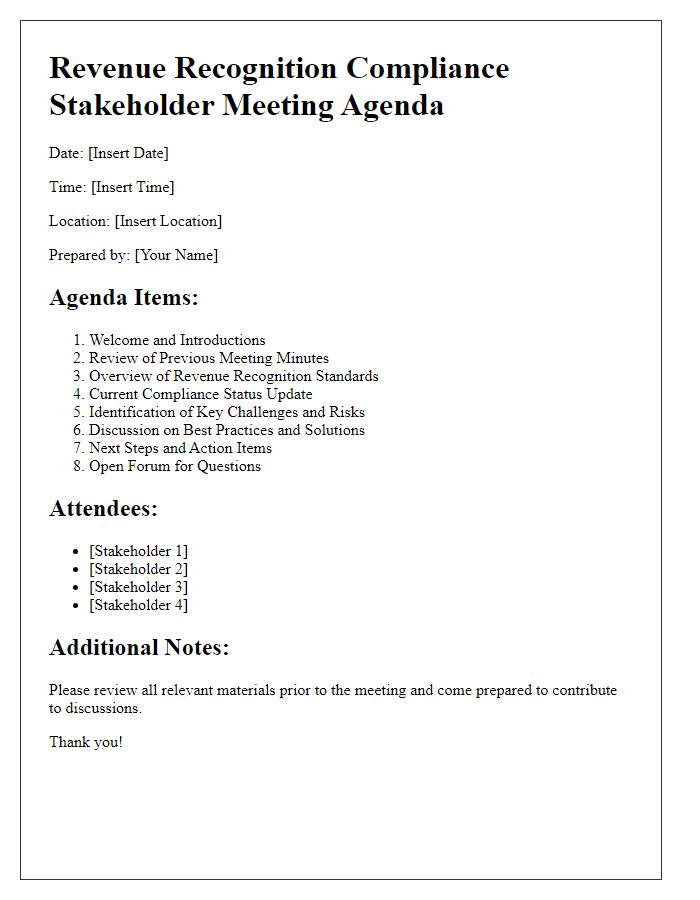In today's fast-paced business environment, staying compliant with revenue recognition standards is more vital than ever. Understanding the nuances of these regulations can be daunting, but it's essential for the financial health of your organization. This update will provide valuable insights into recent changes and best practices for ensuring compliance. Ready to dive deeper into this crucial topic? Read on!

Compliance regulations
Revenue recognition compliance standards, such as ASC 606 (Applicable to U.S. GAAP) and IFRS 15, require organizations to report revenue accurately and consistently. These regulations mandate that companies recognize revenue only when the transfer of control occurs, rather than upon delivery or receipt of payment. Significant details include identifying performance obligations, determining transaction prices, and allocating revenue to each performance obligation based on its relative standalone selling price. Companies must disclose qualitative and quantitative information about revenue recognition practices, including significant judgments and changes in assumptions. Compliance with these standards is critical for accurate financial reporting and maintaining investor confidence.
Revenue recognition criteria
Revenue recognition compliance is crucial for businesses adhering to the Financial Accounting Standards Board (FASB) guidelines. According to ASC 606, revenue from contracts with customers should be recognized when control of the goods or services is transferred to the customer, which may involve multiple performance obligations. This standard applies to various industries, including technology, retail, and manufacturing. Key steps include identifying the contract, determining performance obligations, setting transaction prices, and recognizing revenue when obligations are satisfied. Companies must also consider factors like variable consideration, significant financing components, and principal versus agent relationships that can influence revenue timing and amounts. Regular updates and training ensure that all departments maintain compliance and align with the latest regulatory changes.
Internal controls and processes
Revenue recognition compliance updates involve the evaluation and enhancement of internal controls and processes to ensure adherence to accounting standards such as ASC 606 or IFRS 15. These standards emphasize the principles of recognizing revenue when control of goods or services is transferred to customers, which necessitates precise documentation and tracking systems to monitor contracts and performance obligations. For organizations in sectors like software, construction, or retail, implementing automated solutions can streamline the revenue recognition process, improving accuracy and reducing the risk of misstatements. Regular training sessions for finance teams on the latest compliance requirements, effective internal audits to evaluate current practices, and clear communication channels for reporting discrepancies are crucial to maintaining robust compliance. Continuous improvement in these areas supports reliable financial reporting and enhances stakeholder confidence.
Financial reporting accuracy
Revenue recognition compliance is crucial for maintaining financial reporting accuracy in companies operating under guidelines such as the Generally Accepted Accounting Principles (GAAP) or the International Financial Reporting Standards (IFRS). For instance, the ASC 606 standard outlines five steps for recognizing revenue, ensuring that organizations such as corporations and nonprofits accurately track earnings from sale transactions. Misalignment in compliance can lead to significant discrepancies in annual financial statements, potentially affecting investor trust and stock market performance. Regular updates and training sessions must be conducted to ensure that teams remain informed about changes in regulations and effective techniques for proper documentation and reporting of revenue streams. Additionally, using sophisticated financial management software can help automate revenue recognition processes, enhancing both accuracy and efficiency in financial reporting.
Stakeholder communication
The recent update on revenue recognition compliance emphasizes adherence to the Financial Accounting Standards Board (FASB) guidelines, particularly ASC 606, which impacts various sectors, including technology and healthcare. Organizations must ensure that their revenue contracts are evaluated in detail by analyzing performance obligations and transaction prices, reflecting a shift towards more transparent financial reporting. Regular training sessions are scheduled for the finance teams, incorporating the latest compliance tools and software, like SAP Revenue Accounting, to facilitate accurate reporting. Stakeholders must be actively engaged through dedicated communication channels to address concerns and clarify compliance processes, ensuring a seamless transition by the year-end financial reporting deadline.
Letter Template For Revenue Recognition Compliance Update Samples
Letter template of revenue recognition compliance questionnaire distribution

Letter template of revenue recognition compliance stakeholder meeting agenda















Comments